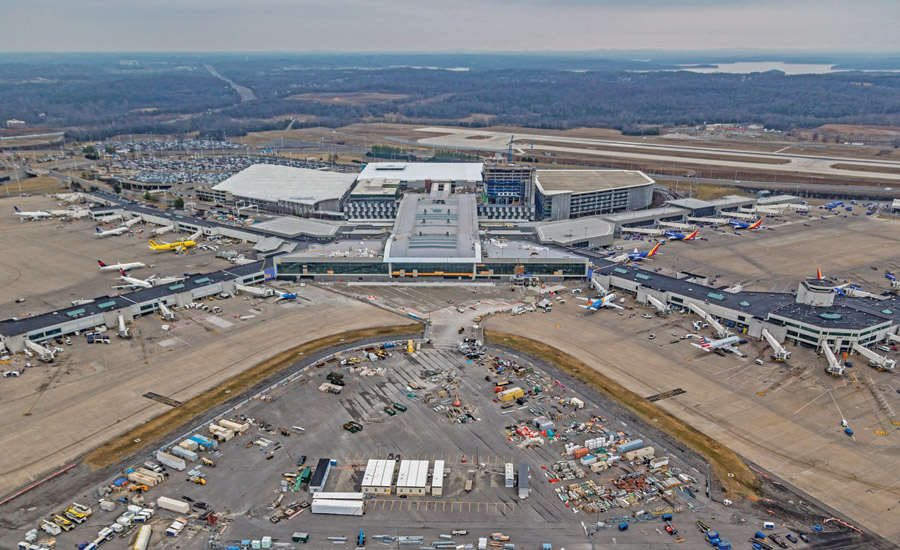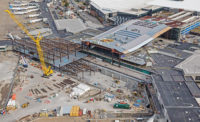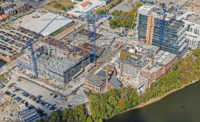In 2019, tens of thousands of travelers made their way through Nashville International Airport, a record-setting year for the 85-year-old facility.
On April 8, 2020, just 545 did.
The COVID-19 pandemic brought air travel in Nashville nearly to a halt—but it didn’t stop the airport from charging ahead with an aggressive construction schedule.
Airport CEO Doug Kreulen says the airport, known as BNA, bet on the future when it was empty and passenger forecasts questionable. During the depths of the pandemic, the airport’s board of commissioners supported awarding the construction of a new satellite concourse for eight gates. Without the foot traffic, they took the opportunity to replace floors years ahead of schedule. They ordered steel, escalators, elevators and large television screens. Given the inflation today, Kreulen says the airport paid relative bargain basement prices.

A progressive design-build delivery method has allowed for a better product, team leaders say.
Photo courtesy Nashville International Airport
“We looked at projects in terms of how can we minimize our risk by purchasing all the steel and everything,” he says. “We wanted to be in the front of the line, and that’s one way we accelerated [the improvement plan].”
It was a gamble that paid off. Passenger numbers quickly jumped higher than they had been before the pandemic. BNA announced a record year for passengers in fiscal year 2022, with 18.4 million passengers, beating 2019’s record by 7% and surpassing fiscal 2021 by more than 8 million passengers.
Airport leadership saw an opportunity and shifted gears, accelerating its roughly $1.5-billion capital improvement plan, dubbed BNA Vision, by almost two decades to accommodate facilities that would now be needed in the next year. Then they stepped on the gas, announcing the New Horizons plan in June and started work in August on another $1.4-billion slate of expansions and new construction.
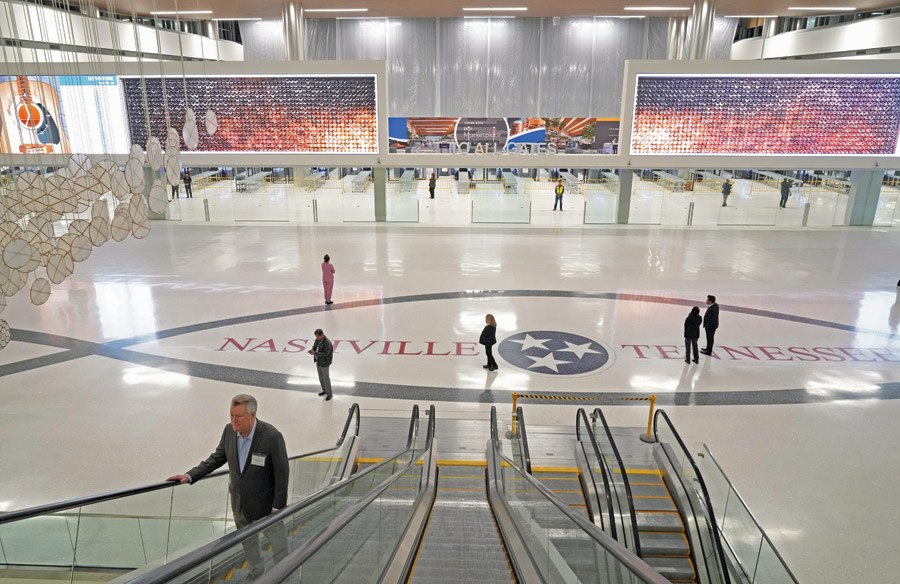
The airport’s flexibility in changing plans, like adding redundancy in escalators and elevators, is one way it has accelerated construction projects.
Betting on the Future
When the new international arrival facility at the airport opens in September, it will mark the completion of six years of work on BNA Vision, but some decisions to speed that project up were made before the passengers came back.
BNA officials took advantage of the relatively empty airport. For example, hundreds of thousands of sq ft of carpet were pulled up and replaced with terrazzo, and the airport access road that would normally have been crammed with cars was improved.
“They’ve had some good foresight,” says Callie Hepler, project manager for Hensel Phelps, which has teamed with Fentress Architects for terminal work at BNA.
She says the airport seized on opportunities that were created by the pandemic, working closely with the project team to accelerate work where possible. For example, Hepler says original designs called for a single set of vertical elevators and escalators, but the decision was made to install the temporary set of elevators and escalators to create redundancy that aided in work later, allowing one set to remain open during construction and adding capacity.
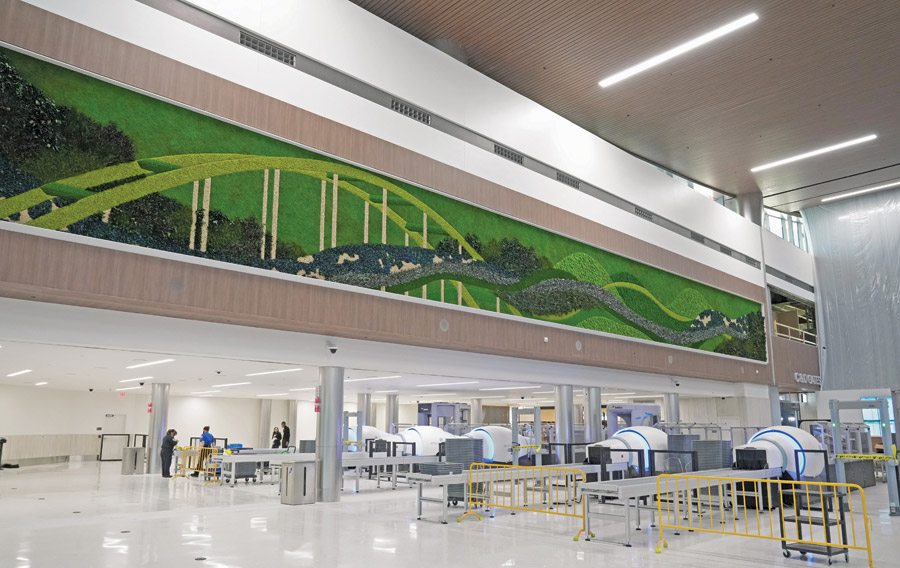
The new security checkpoint and terminal lobby were recently completed. The airport now is turning its attention to further concourse expansions.
Photo courtesy Nashville International Airport
When work began directly above the sole roadway in and out of the airport, the team moved to working nights and pushed all traffic to a single lane to minimize impacts. The airport held up its end of the bargain by working with contractors on airline schedules to further minimize conflicts.
“They certainly are more involved on the day-to-day level,” Hepler says, including nightly coordination calls and biweekly vision meetings. “It’s just very well run, and everyone seems to be in sync.”
With a team designated specifically for the project, BNA eliminated much of the bureaucracy, she says, adding that she is always talking to a decision-maker and a connected network of representatives of airport operations, landside and airside operations and maintenance who attend weekly owner-contractor meetings.
“They certainly are more involved on the day-to-day level. It’s just very well run, and everyone seems to be in sync.”
—Callie Hepler, Project Manager, Hensel Phelps
It translates to a better product, Hepler says, pointing to the redundancy the airport added and the details like electrochromic glazing on the edge of the terminals that changes tint based on time of day and weather conditions to minimize energy consumption. The airport was also able to beat its LEED certification goals, achieving LEED Silver for Concourse D, LEED Gold for the administration building and Parksmart Bronze and Parksmart Silver certifications for garages 2 and 1, respectively. Hensel Phelps recently turned over the terminal lobby and new security checkpoint, and BNA has doubled its terminal through the BNA Vision project to approximately 850,000 sq ft, not including the satellite concourse set to open this fall.
Hepler says the progressive design-build project has evolved significantly between when it was bid in 2018 and 2021, when the guaranteed maximum price was finalized. The airport, she says, added about 25% to the contract value through that phase, expanding the ground transportation and rental car areas that weren’t part of the original design and adding other redundancies as traffic came roaring back.
The contractors are the experts in construction, Kreulen says, so freeing them up to innovate to save time or save money has kept the project on track. Among the recently delivered projects are a six-gate concourse extension, parking garage, administration building and the new Concourse D, delivered in June 2020, says Traci Holton, BNA’s vice president, chief engineer and deputy COO. Now the airport has six projects either procured, under design or in construction.
Holton, a 20-year BNA veteran who has attended meetings for BNA Vision every Thursday morning since 2016, says progressive design-build is the fastest delivery method, offering the most flexibility for the owner and fostering a team environment that’s important to meet owners’ needs, though it does require owners to make decisions quickly.
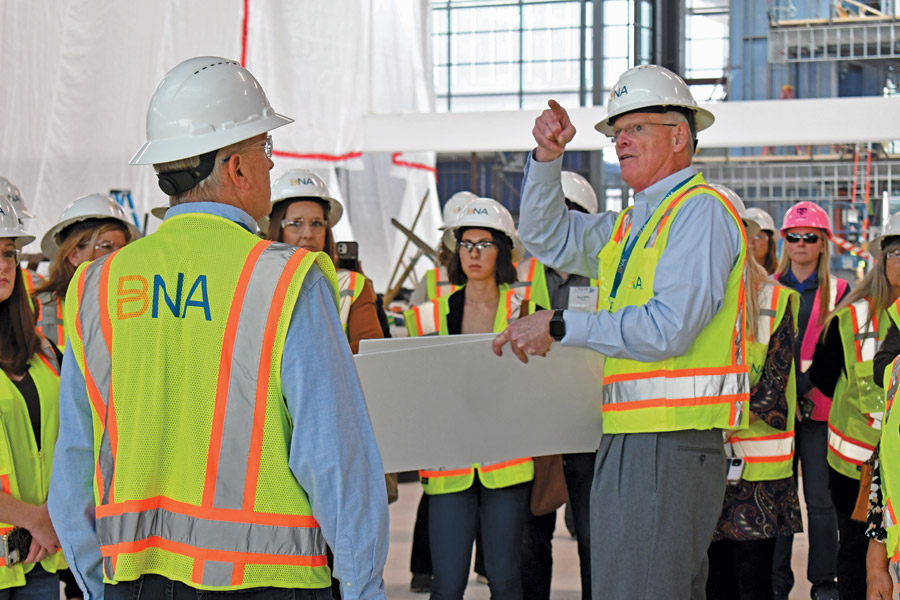
Nashville International Airport CEO Doug Kreulen says allowing contractors to innovate has kept the project on track.
Photo courtesy Nashville International Airport
Expanding a Vision
A prime example of that flexibility is the suggestion from the design-build team to raise the grand lobby roof by about 14 ft, she says, allowing BNA to add a mezzanine level. Further improvements to Concourse D project will kick off the New Horizons work as progressive design-build, Holton adds, but later work will likely be construction manager at-risk as the airport hopes to devote more time on a separate design contract.
Passenger numbers have climbed to new heights thanks to Nashville and Tennessee’s appeal to visitors, but also due to local economic development efforts that never slowed down, Kreulen says. Companies like Amazon, Oracle and Under Armour have announced plans to locate or expand near Nashville and pay salaries that allow employees the opportunity to travel.
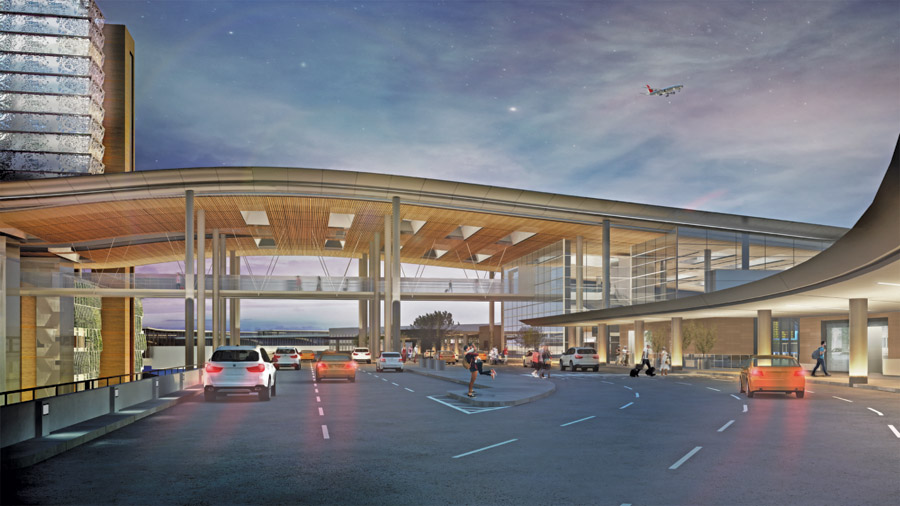
Improving the airport’s terminal roadway is part of its $1.4-billion New Horizons plan, along with expansions to two concourses and a new air freight building.
Photo courtesy Nashville International Airport
“It just kept going and it kept going, and every time we see that, we think, ‘Oh man, we’re going to need a bigger airport,” he says. “They need it for the businesses and ancillary companies that come in to support businesses.”
BNA set a record in 2022 by screening the most passengers in one month, 840,258 in May, and by accommodating its most-ever travelers in a single day: 33,317 on June 26. It opened 49 new food, beverage and retail concepts as it reimagined its concessions program. According to BNA, its economic impact in 2019 totaled more than $8 billion, supporting more than 76,000 jobs and producing more than $443 million in taxes while receiving no local tax dollars. Seventeen airlines offer 88 nonstop destinations with an average 272 daily departures. The airport currently has four runways, with long-term plans to add a fifth.
“We spend a lot of time forecasting,” Kreulen says. “Well, our last four forecasts—2013, 2016, 2018 and 2020—have all been wrong. Nashville has grown faster than that.”
“Our last four forecasts— 2013, 2016, 2018 and 2020—have all been wrong. Nashville has grown faster than that.”
—Doug Kreulen, CEO, Nashville International Airport
So they’re betting on the future again. BNA didn’t waste time launching the $1.4-billion New Horizons, starting work in August to expand two concourses, construct a new air freight building and improve the terminal roadway and baggage handling system over the next five years. On Jan. 27, workers topped out a nine-story, 292-room hotel on site, BNA’s first.
At the start of BNA Vision, the airport was hosting between 14 million and 15 million passengers annually. At the project’s close, that number is up to 21 million, and Kreulen says the airport’s new aim is to accommodate 35 million passengers and expand to a total of 70 gates from the current 55.
It’s the project of a lifetime for Holton, who says the airport has always been busy, but the current growth and slate of construction work is one of a kind.
But paying for it will be a challenge, Kreulen says, but he notes increased parking and added food, beverage and retail businesses inside the airport. Those establishments have nearly doubled, from 52 in 2017 to 98 in October 2022, with local businesses gaining more of a foothold, from 10-15% to now nearly 50%.
“We’ve done all of this and we’ve never closed,” Kreulen says. “To have that many people going through a construction area, and to keep customer service at very high levels and facilitate passenger needs, I would say that’s our largest accomplishment.”
